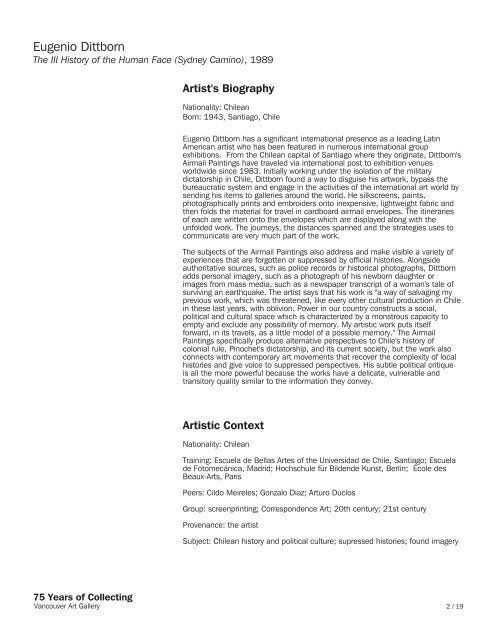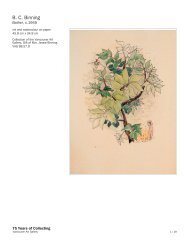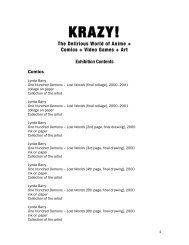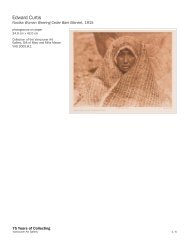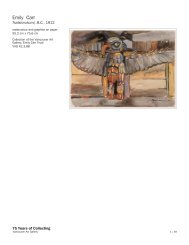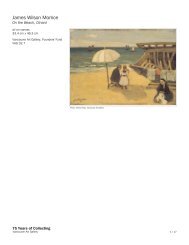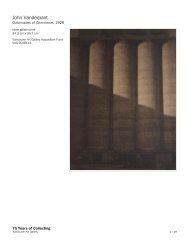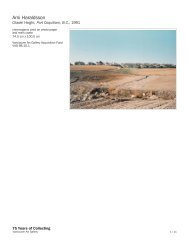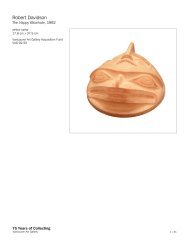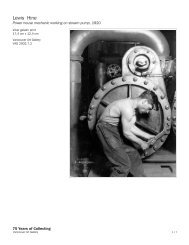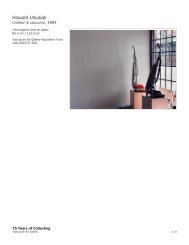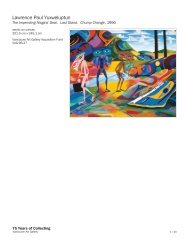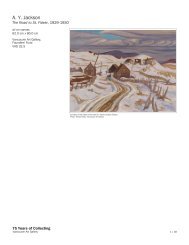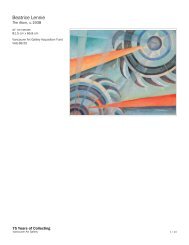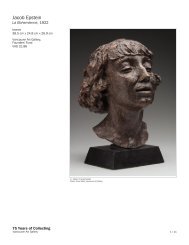Eugenio Dittborn - 75 Years of Collecting - Vancouver Art Gallery
Eugenio Dittborn - 75 Years of Collecting - Vancouver Art Gallery
Eugenio Dittborn - 75 Years of Collecting - Vancouver Art Gallery
Create successful ePaper yourself
Turn your PDF publications into a flip-book with our unique Google optimized e-Paper software.
<strong>Eugenio</strong> <strong>Dittborn</strong><br />
The III History <strong>of</strong> the Human Face (Sydney Camino), 1989<br />
<strong>75</strong> <strong>Years</strong> <strong>of</strong> <strong>Collecting</strong><br />
<strong>Vancouver</strong> <strong>Art</strong> <strong>Gallery</strong><br />
<strong>Art</strong>ist's Biography<br />
Nationality: Chilean<br />
Born: 1943, Santiago, Chile<br />
<strong>Eugenio</strong> <strong>Dittborn</strong> has a significant international presence as a leading Latin<br />
American artist who has been featured in numerous international group<br />
exhibitions. From the Chilean capital <strong>of</strong> Santiago where they originate, <strong>Dittborn</strong>'s<br />
Airmail Paintings have traveled via international post to exhibition venues<br />
worldwide since 1983. Initially working under the isolation <strong>of</strong> the military<br />
dictatorship in Chile, <strong>Dittborn</strong> found a way to disguise his artwork, bypass the<br />
bureaucratic system and engage in the activities <strong>of</strong> the international art world by<br />
sending his items to galleries around the world. He silkscreens, paints,<br />
photographically prints and embroiders onto inexpensive, lightweight fabric and<br />
then folds the material for travel in cardboard airmail envelopes. The itineraries<br />
<strong>of</strong> each are written onto the envelopes which are displayed along with the<br />
unfolded work. The journeys, the distances spanned and the strategies uses to<br />
communicate are very much part <strong>of</strong> the work.<br />
The subjects <strong>of</strong> the Airmail Paintings also address and make visible a variety <strong>of</strong><br />
experiences that are forgotten or suppressed by <strong>of</strong>ficial histories. Alongside<br />
authoritative sources, such as police records or historical photographs, <strong>Dittborn</strong><br />
adds personal imagery, such as a photograph <strong>of</strong> his newborn daughter or<br />
images from mass media, such as a newspaper transcript <strong>of</strong> a woman's tale <strong>of</strong><br />
surviving an earthquake. The artist says that his work is "a way <strong>of</strong> salvaging my<br />
previous work, which was threatened, like every other cultural production in Chile<br />
in these last years, with oblivion. Power in our country constructs a social,<br />
political and cultural space which is characterized by a monstrous capacity to<br />
empty and exclude any possibility <strong>of</strong> memory. My artistic work puts itself<br />
forward, in its travels, as a little model <strong>of</strong> a possible memory." The Airmail<br />
Paintings specifically produce alternative perspectives to Chile's history <strong>of</strong><br />
colonial rule, Pinochet's dictatorship, and its current society, but the work also<br />
connects with contemporary art movements that recover the complexity <strong>of</strong> local<br />
histories and give voice to suppressed perspectives. His subtle political critique<br />
is all the more powerful because the works have a delicate, vulnerable and<br />
transitory quality similar to the information they convey.<br />
<strong>Art</strong>istic Context<br />
Nationality: Chilean<br />
Training: Escuela de Bellas <strong>Art</strong>es <strong>of</strong> the Universidad de Chile, Santiago; Escuela<br />
de Fotomecánica, Madrid; Hochschule für Bildende Kunst, Berlin; École des<br />
Beaux-<strong>Art</strong>s, Paris<br />
Peers: Cildo Meireles; Gonzalo Diaz; <strong>Art</strong>uro Duclos<br />
Group: screenprinting; Correspondence <strong>Art</strong>; 20th century; 21st century<br />
Provenance: the artist<br />
Subject: Chilean history and political culture; supressed histories; found imagery<br />
2 / 19


